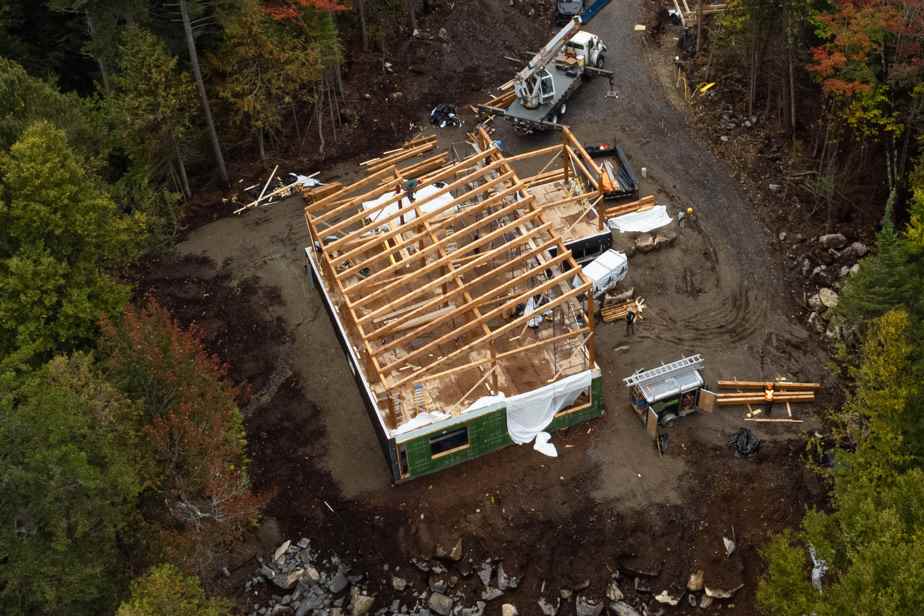To build the ideal house, which is energy efficient, healthy, durable and warm, building science has made giant strides. But the ancestral know-how has not said its last word. As proof, a Quebec company relies on mortise and tenon frames, an age-old method, for its ecological houses.
Posted at 12:00 p.m.
The sky is low and the wind is icy. But Bruno Lagendyk smiles broadly. “I take a lot of photos, I’m a little ecstatic, the house is finally taking shape! “, he says while a crane hoists a pine plank, which two workers will fix to the structure that appeared in less than two days among the hills of Val-Morin, in the Laurentians.
The newly retired engineer and his wife will have to wait until the end of winter to settle there, but they already see each other in this future home that they wanted to be made of natural materials, to avoid toxic volatile organic compounds, well insulated, with lots of exposed wood and able to withstand time.

PHOTO HUGO-SÉBASTIEN AUBERT, THE PRESS
Bruno Lagendyk, owner
This is our last house, I want it to last 100 years!
Bruno Lagendyk, owner
That’s good, that’s exactly what Linéaire Design offers, the eco-construction company founded in L’Islet a little over 15 years ago by brothers Samuel and Dominique Pépin-Guay, two wood enthusiasts for … still. “Our parents were in the business of restoring and recovering old buildings,” says Samuel. We’ve been in it all our lives. »
A life in the woods
Trained in cabinetmaking, the Pépin-Guay brothers first got into furniture in the early 2000s, but they quickly decided to focus on construction by focusing on solid wood frames, where all the pieces are interlock like Legos with tenons (protruding ends) and mortises (notches).
-

PHOTO HUGO-SÉBASTIEN AUBERT, THE PRESS
The assembly of the frame of this house in Val-Morin took less than two days.
-

PHOTO HUGO-SÉBASTIEN AUBERT, THE PRESS
Each piece made in the workshop is numbered to be assembled quickly.
-

PHOTO HUGO-SÉBASTIEN AUBERT, THE PRESS
A few hammer blows are generally enough to insert the tenons into the mortises. Preceded, if necessary, by a stroke of the plane or two.
1/3
This way of building is very durable. On the one hand because the structures can last for centuries, on the other hand because they generate little waste. “It is possible to dismantle a wooden house like this that is 200 years old to make a new one without sending almost anything to the dump”, illustrates Samuel Pépin-Guay.
If old houses are known for their longevity, they are less so for their energy efficiency. “On that side, it’s not terrible,” admits the manufacturer. However, there are now ways to fill this gap. In recent years, Linear has therefore perfected the alliance between timeless know-how and quality technical materials, most of which are made in Europe.
A house built “upside down”
The house born of this union, baptized Ultima Éco, is surprising, in particular because it is built “upside down”, starting with the interior. “Our structural framework is 100% inside the house, it is part of the furniture,” explains Samuel Pépin-Guay. The insulation, the walls, the roof, everything rests on this frame, which will remain visible to the occupants.
To ensure good energy efficiency, “we work with onion skins”, continues the designer. A succession of layers affixed to the frame forms an envelope that cuts thermal bridges and traps heat (or coolness). But not humidity, and this is another peculiarity of these constructions.
Indeed, the addition of a “breathing” membrane on the solid wood structure, the hemp insulation and the aspen panels that replace the gypsum ensure that the house itself regulates humidity, which improves air quality and prevents mold problems.

PHOTO HUGO-SÉBASTIEN AUBERT, THE PRESS
Samuel Pépin-Guay, co-founder of Linéaire Design
Our house is like a Gore-Tex coat, which breathes, but which keeps you warm when cross-country skiing.
Samuel Pépin-Guay, co-founder of Linéaire Design
This way of building is more expensive, around 10% to 25%, the company assesses. But the gains in energy, and on the resale value, come to rebalance things. To reduce the price, Linear sticks to simple modular volumes, without gables or skylights. The use of structural screws, a departure from tradition, also saves time (and money) during assembly.
-

PHOTO STÉPHANE BOURGEOIS, PROVIDED BY LINEAR DESIGN
To reduce the price, Linear sticks to simple modular volumes, as for this chalet.
-

PHOTO STÉPHANE BOURGEOIS, PROVIDED BY LINEAR DESIGN
The solid wood frame, made mainly of oil-treated pine, remains visible. Walls, insulation and roof are supported by the structure.
-

PHOTO STÉPHANE BOURGEOIS, PROVIDED BY LINEAR DESIGN
You have to love wood when you choose a house designed by Linéaire. The “modern rustic look” holds up well to the test of fashion, believes Samuel Pépin-Guay.
1/3
Linear delivers its houses in kits, but a general contractor, Larix Construction in the case of Val-Morin, assembles the spare parts.
Does using so much wood to build a house risk emptying the forests? No, reassures Samuel Pépin-Guay, who also founded the Tree-evolution cooperative, whose reforestation mission wants to compensate for all the trees felled.
-

PHOTO STÉPHANE BOURGEOIS, PROVIDED BY LINEAR DESIGN
Linéaire Design’s model home in L’Islet, east of Quebec
-

PHOTO STÉPHANE BOURGEOIS, PROVIDED BY LINEAR DESIGN
In addition to visiting the house, potential buyers can make a short stay there.
1/2
Linear has a model home in L’Islet, near Quebec. A second “showcase” building, housing several dwellings, should also come out of the ground shortly on the Côte-du-Sud. Potential buyers can already visit the first… and even make a short stay there, just to test the concept. And who knows, maybe they too will soon jump for joy, camera in hand, on a construction site!

